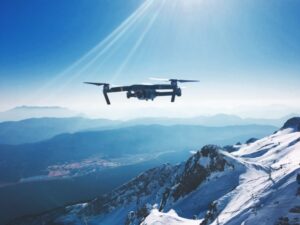Original public domain image from Wikimedia Commons
CAV Systems Files for Patent for Ice Protection Solution for Drones
by DRONELIFE Staff Writer Ian M. Crosby
CAV Ice Protection Limited, an airborne ice protection solutions supplier and part of the CAV Systems Group, has filed for a patent for a solution for small uncrewed aerial systems (sUAS) that could dramatically improve the operation of commercial drones in cold climates. The company’s engineers designed a concept ice protection system (IPS) that prevents the build-up of ice on the rotor blades of a drone or sUAS, which it is currently looking to bring to market.
“This is an industry first, nobody has previously demonstrated an ice protection system that works for this size of aircraft, and we’re not aware that anybody else is working on one,” said CAV Systems’ VP of Engineering Alex Baty. “We’re ahead of the curve in that respect and it has attracted the attention of some major distributors. We know that, globally the use of drones for last mile delivery is already in action. We hope that our anti-icing system can help to tackle a significant obstacle to widespread drone usage. Our testing has seen the effects of icing on a propeller will cause a 50% reduction in lift generation after just three minutes, which underlines the impact that icing can have on sUAS.
“If sUAS-based product delivery is to move forward, and become viable across a range of geographical locations, then ice-protection will need to be factored in, in order to guarantee safe, efficient and reliable flying. There are some potential niche applications as well: the idea has been explored of using sUAS to launch flares that would seed clouds with silver oxide particles for weather modification. Imagine being able to use unmanned aircraft to remove freezing fog conditions around an airport,” Baty continued.
The solution functions by distributing freezing-point depressant fluid along the edges of the aircraft’s carbon-fiber blade.
The system’s initial tests started with a single 18” diameter motor and propeller assembly before moving on to an Octocopter. Additional tests incorporated models with and without the IPS in an icing wind tunnel replicating freezing conditions.
The tests found that the application of the CAV IPS to the propeller resulted in lift of the model reducing by as little as 10%, with minor changes to power compared to ice build-up, and a 50% reduction of ice. Twice the electrical power was consumed when foregoing the ice protection.
Engineers at CAV Systems brought the Octocopter system’s weight to below 2kg, approximately 20% of the test model’s total payload, which the engineers believe can be brought down by a further 25% depending on the aircraft’s total flight plan.
“The work we have done, and are continuing to do, around weight reduction will have a huge bearing on the solution. When a drone has a payload of around 10kg, 500g is a significant percentage,” Baty added.
Read more:
Ian attended Dominican University of California, where he received a BA in English in 2019. With a lifelong passion for writing and storytelling and a keen interest in technology, he is now contributing to DroneLife as a staff writer.
Miriam McNabb is the Editor-in-Chief of DRONELIFE and CEO of JobForDrones, a professional drone services marketplace, and a fascinated observer of the emerging drone industry and the regulatory environment for drones. Miriam has penned over 3,000 articles focused on the commercial drone space and is an international speaker and recognized figure in the industry. Miriam has a degree from the University of Chicago and over 20 years of experience in high tech sales and marketing for new technologies.
For drone industry consulting or writing, Email Miriam.
TWITTER:@spaldingbarker
Subscribe to DroneLife here.
https://dronelife.com/2023/03/21/ice-protection-for-drones-cav-systems-files-patent/
